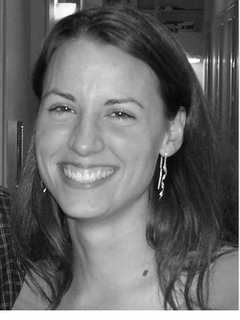A new friend of mine down here, south of the Equator, is a girl from Colorado-Minnesota named Stephanie.

Steph is taking classes and teaching English until December in Quito. She lives with a woman. her "mom" and the woman´s daughter, her "sister." The mom works for a tourism-supporting national agency and was involved in the planning for the "Third Annual Adventure Sports Workshop" (Tercer Taller de Deportes Adventuras). Steph´s mom told her about the workshop and Steph invited me to come along... so I did;-).

It was a fun time and a whirlwind introduction to "adventure sports." Ironically, I think Steph and I had more experience with outdoor sports than most of the future-guide participants. Enjoying the outdoors is just now becoming more "de
moda" (in style) among those who can afford leisure time in Ecuador.Steph and I actually missed the first day of "classroom" training, but from what I heard is was pretty straightforward stuff... basic camping and outdoor skills.

The first morning, we first hiked through a reserve, Cuichocha with a crater lake, which was absolutely beautiful! (see above). Below is a model of the landscape in the area.

The majority of the participants (we were a group of 90+) in this workshop were students in Ecuadorian universities studying either Eco Tourism, or Hotel Management. Below is a pic of some of the participants during a bus game we played to build our "team" for the weekend´s activities.
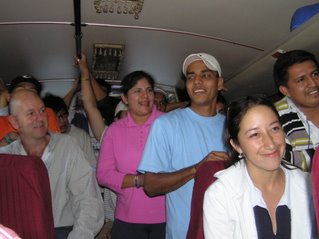
Also participating were professionals already involved in Ecuadorian tourism, hotel management, and government tourism representatives... Oh yea, and two random high school art students (German and Italian nationals), and two random US citizens (Steph and me). The instructors were from the Ecuadorian Red Cross, Ecuadorian Diving Confederation, and national tourism agencies.
The afternoon, evening of the first day we got to "dive" with an instructor in the crater lake. This was pretty cool, even though it was a short (both in length of time and depth) experience. We only went down about 5-10 meters and checked out some of the thermal vents. Below is a pic of me being outfitted for the dive;-).

Unfortunetly the only live things I saw was seaweed, so I was a bit dissapointed about that.
Here is a view from between the two islands in the lake, where we did our "diving." The itty-bitty point sticking up over the crater lake rim is the tallest part of Volcan Cotacachi.
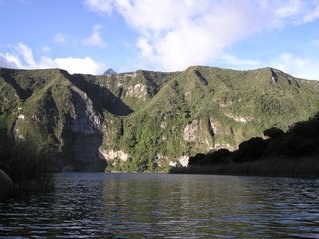
The next day we left for our camping site near a river in one of the valleys that in the model pictured above. We did a bit of rafting and had a first aid-safety workshop.

During the first aid workshop I decided I would make a first aid kit for my jungle trip the following weekend! Putting this kit together in Quito was actually quite a challenge, but I must say it is pretty impressive given the circumstances.

Conveniently our camp was located at a Cabañas lodge with thermal pools and we got to use them to relax during the evening.

The last morning´s activity was "canyoning", repelling down a waterfall. This ended up being pretty fun....


EXCEPT I made a really bad decision in wearing my glasses... sans any sort of strap (I had lost a contact). Here´s a pic of me... blind!, after losing my glasses.
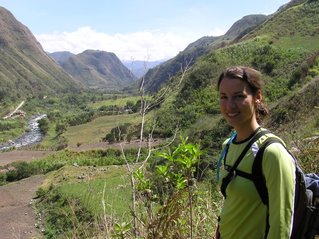
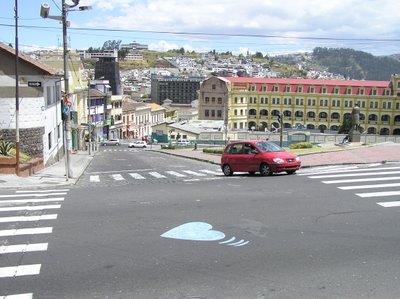 The crashes seem to be more the result of unsafe driving practices: brake problems, late night driving with unsafe drivers, etc, rather than bad roads. The roads and highways are actually in decent shape, particularly compared to many of the roads I saw last year in Peru.
The crashes seem to be more the result of unsafe driving practices: brake problems, late night driving with unsafe drivers, etc, rather than bad roads. The roads and highways are actually in decent shape, particularly compared to many of the roads I saw last year in Peru.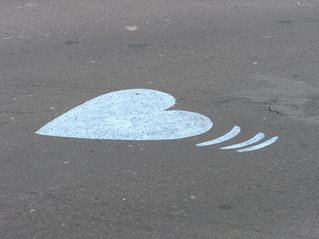 Apparently the influx of oil money during the last 20- 30 years has allowed investment in safer roads... also the use of the roads by oil companies resulted in highway investments (something I noticed last week on a trip to "la selva", the jungle, where most of the oil production takes place).
Apparently the influx of oil money during the last 20- 30 years has allowed investment in safer roads... also the use of the roads by oil companies resulted in highway investments (something I noticed last week on a trip to "la selva", the jungle, where most of the oil production takes place). Ecuador doesn't make nearly the revenues, however, which it could from its oil production. Only 30 percent of the country's oil is refined within. The remainder is exported to other countries for refining and creation of oil byproducts and Ecuador must buy these byproducts internationally rather than domestically. The same scenario is true of many Ecuadorian products: despite the fact the country has rich agricultural and natural resources, they are sold (and exported) in their primary forms, the cheapest products, rather than developed products which have greater profit margins.
Ecuador doesn't make nearly the revenues, however, which it could from its oil production. Only 30 percent of the country's oil is refined within. The remainder is exported to other countries for refining and creation of oil byproducts and Ecuador must buy these byproducts internationally rather than domestically. The same scenario is true of many Ecuadorian products: despite the fact the country has rich agricultural and natural resources, they are sold (and exported) in their primary forms, the cheapest products, rather than developed products which have greater profit margins.













